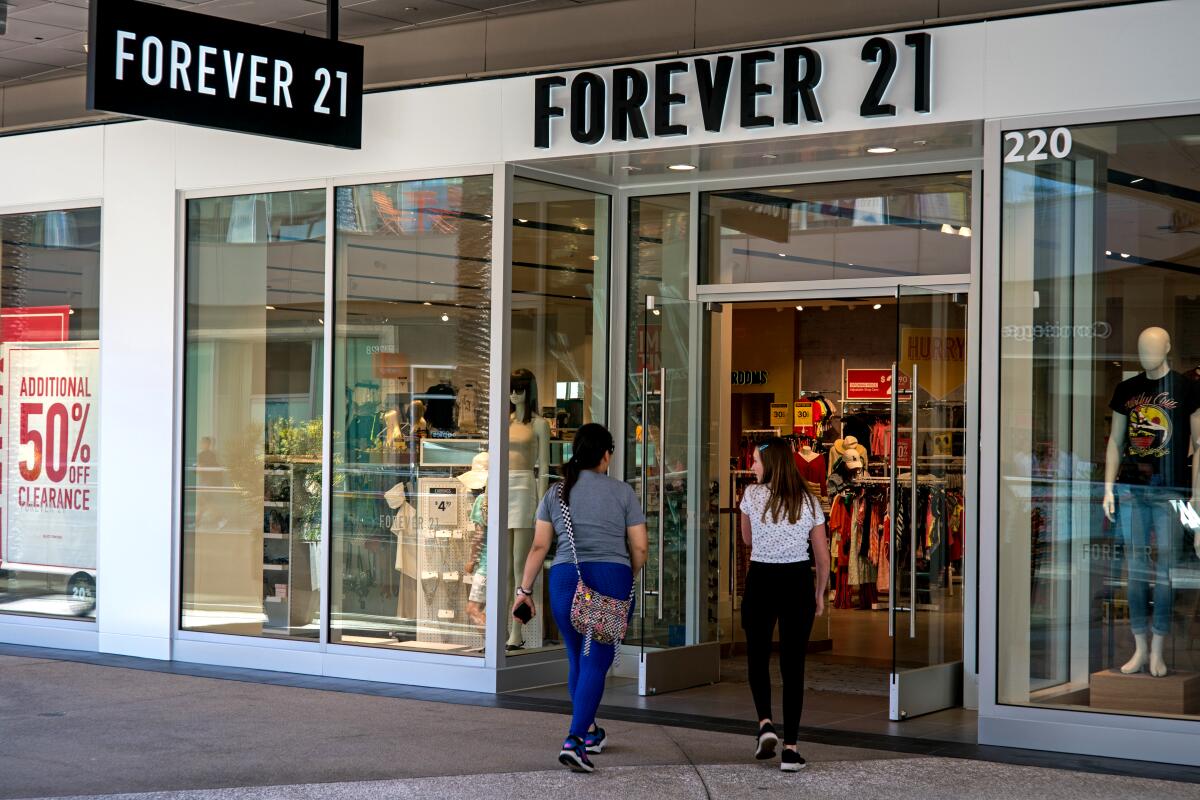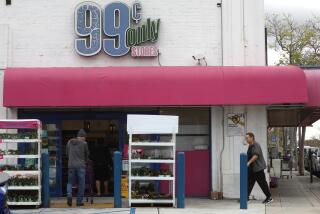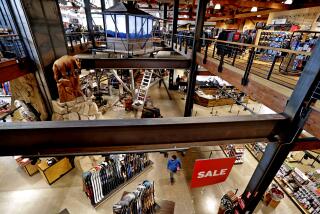Why Forever 21 filed for bankruptcy: Big stores, small crowds

Forever 21 Inc. joined the ever-growing numbers of apparel retailers that have filed for bankruptcy -- a list from which few clothiers have bounced back.
The Los Angeles company is a leading player in fast fashion, where it quickly updates its moderately priced inventory to keep pace with the latest trends, and with 800 stores – many of them exceptionally large – it’s become a familiar anchor tenant in shopping malls.
But Forever 21 fell victim to a combination of slower mall traffic, dissatisfaction with its clothes, its own over-expansion and the ongoing consumer shift to online shopping, all of which created a cash crunch that forced the firm to file for Chapter 11 bankruptcy protection late Sunday.
Under Chapter 11, Forever 21’s debts are frozen while it continues operating and works out a reorganization plan. Its plan calls for closing about 350 stores — including 178, or one-third, of its 549 U.S. locations. Forever 21 hasn’t yet revealed which stores will be shuttered.
The firm’s 44 Canadian stores, and most of its locations in Asia and Europe, also will be closed.
The privately owned chain also said it had secured $350 million in restructuring financing to help it reorganize and prepare for the crucial holiday shopping season.
Forever 21 is the latest, and one of the largest, retailers to seek bankruptcy in the last two years. Many are traditional operators of brick-and-mortar stores, such as Toys R Us and Sears Holdings, which have been hit hard by consumers’ increasing shift to e-commerce.
In the apparel sector they include American Apparel, Rue21, Payless ShoeSource, Charlotte Russe, Wet Seal, BCBG Max Azria, Gymboree and True Religion.
The bankruptcies are a key reason why U.S. retailers have closed 8,567 stores so far this year, up 47% from the 5,844 outlets closed in all of 2018, according to Coresight Research.
Forever 21 said its reorganization would leave the chain “better positioned to prosper for years to come.” But some analysts said that while Chapter 11 would help the company right itself financially, Forever 21 still faces the challenge of rebuilding its brand so that it can grow again one day.
“It is possible to come back but it’s rare,” said Ronald Friedman, co-head of the retail practice at Marcum, an accounting and advisory firm.
Forever 21 is owned by husband-and-wife team Do Won Chang and Jin Sook Chang, who started with a single store in Los Angeles’ Highland Park neighborhood in 1984 and grew it to a global fashion staple with annual sales of about $3 billion.
The retailer was known for providing tops, pants and other apparel – typically for $20 or less each – to teenage buyers who were constantly searching for the latest trends, often because they were influenced by their favorite celebrities on social media. Two other big chains, H&M and Zara, also compete with Forever 21 in the fast-fashion sector.
Forever 21 was unique in that it pursued massive stores, often with 38,000 or more square feet, many of which it obtained after the severe recession in 2008-09 when some department stores sought bankruptcy protection or liquidation. The recession also heightened Forever 21’s appeal as consumers looked for low prices.
To help fill those big stores, Forever 21 eventually broadened its lines of merchandise to include menswear, children’s clothing, maternity and plus-size apparel, cosmetics and other items. But that expansion turned off a good number of its core young apparel buyers, analysts have said.
That exacerbated the damage Forever 21 suffered from the overall slowdown in foot traffic at shopping malls that’s bedeviled retailers of all stripes, as buyers increasingly shift to purchasing online.
“The brick-and-mortar retailers that relied on you being in the store to capture your sales, even with large inventories, are now susceptible to how those shopping patterns are changing,” said Roger Beahm, executive director of the Center for Retail Innovation at Wake Forest University.
In addition, “fashion is about image; image is important to people,” Beahm said of Forever 21’s reputation. “If there’s a tarnished image about that brand, few customers are going to develop a strong loyalty toward it.”
Friedman said that once Forever 21 downsizes, “they have to go back to what their core principles were all about and who they used to cater to” in order to stay relevant because the chain “lost their teenage buyer. The teenage buyer is always looking for the new thing.”
Indeed, young shoppers have migrated to online sites such as Fashion Nova, Asos, Boohoo and Missguided, among others, as well as e-commerce giant Amazon.com and clothing resellers such as Poshmark and Depop.
For that reason, Forever 21 also needs to upgrade its website because “it has to have that online visibility” to complement its physical stores, Friedman said.
Forever 21’s plan to slash the number of its stores is more bad news for mall operators, namely Simon Property Group Inc. and Brookfield Property Partners, two of the firm’s biggest landlords. But their stocks fell only modestly Monday, probably because investors had read media reports for weeks that Forever 21 might seek bankruptcy.
In a note to customers posted on Forever 21’s website, the firm said that decisions as to which U.S. stores will close “are ongoing, pending the outcome of continued conversations with landlords,” but that Forever 21 does “not expect to exit any major markets in the U.S.”







